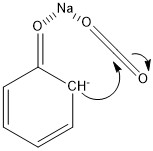textex
Harmless

Posts: 26
Registered: 29-3-2011
Member Is Offline
Mood: No Mood
|
|
Kolbe Schmitt mechanism
Hiya,
as a part of a school assigment we're going to write some mechanism and explain the Kolbe-Schmitt reaction.
I was a bit to fast(and maybey a bit lazy) about the drawing the mechanism, as it seems like the cation do more than simply sitting there.
I have searched a bit, and I see that one of the intermediates is some kind of complex, and that Sodium favours a orto reaction, but I can't really
get why, and why a Potassium salt would give a bigger fraction of para-hydroxybenzoic acid.
That being said, the class the assignment is related to is just basic university organic chemistry, and we haven't had that much inorganic either. So
if the reason is too complicated I guess i could get away without eloborating it to much.
But if any of you got some good references or explanations of it, I would really apreciate it! 
I've also attached a quick sketch of the mechanism I made. And I see that I should add the Sodium Cation, but is there anything else that doesen't
look right?
Attachment: Reaksjonsmekanisme Salisylsyre.pdf (24kB)
This file has been downloaded 450 times
|
|
|
Galinstan
Hazard to Self
 
Posts: 53
Registered: 22-11-2013
Location: England
Member Is Offline
Mood: No Mood
|
|
From what i can see the sodium salt gives the ortho product and the potassium salt gives a larger fraction of para is because with the Na salt this
intermediate is formed in the attachment where as the K ion being larger doesn't form this intermiate as the Na intermediate aids in directing to the
ortho.

|
|
|
Nicodem
|
Thread Moved
28-3-2014 at 06:29 |
Nicodem
Super Moderator
      
Posts: 4230
Registered: 28-12-2004
Member Is Offline
Mood: No Mood
|
|
Reaction reviews:
The Kolbe-Schmitt reaction. Chem. Rev. 1957, 57, 583–620.
Mechanism:
Carboxylations of alkali metal phenoxides with carbon dioxide. Org. Biomol. Chem. 2003, 1, 817–821.
Theoretical study of the Kolbe-Schmitt reaction mechanism. Z. Naturforsch., A: Phys. Sci. 2002, 57, 812–818.
Mechanism of the Kolbe-Schmitt reaction. Structure of the intermediate potassium phenoxide-CO2 Complex. J. Chem. Inf. Model. 2007, 47, 1520-1525.
A theoretical study of solvent effects on Kolbe–Schmitt reaction kinetics. Chem. Eng. Sci. 2006, 61, 6199–6212.
Mechanism of the Kolbe-Schmitt reaction. Part I. Infra-red studies. J. Chem. Soc. 1954, 3145–3151.
Isolation of intermediates:
Carboxylation of phenol derivatives. XXI. The formation reaction of the complex from alkali phenoxide and carbon dioxide. Bull. Chem. Soc. Jpn. 1973,
46, 3470–3474.
Effects of the cation:
Effects of alkali and alkaline earth metals on the Kolbe–Schmitt reaction. Bull. Chem. Soc. Jpn. 2002, 75, 619–622.
JP2004346009A
Carboxylation of phenolates in solutions (different mechanism):
β-Resorcylic acid. Org. Synth. 1930, 10, 94.
Zur kenntnis der p-amino-salicylsaure und strukturahnlicher verbindungen. Helv. Chim. Acta 1948, 31, 988–992.
The Kolbe-Schmitt reaction in aqueous solutions. J. Chem. Soc. Japan 2002, 467–469.
Enantioselective synthesis of (R)-(+)-pulvilloric acid. Liebigs Ann. Chem. 1997, 213–216.
Carboxylation of substituted phenols in N,N-dimethylamide solvents at atmospheric pressure. J. Chem. Eng. Data 1969, 14, 388–391.
Simple Synthesis of 3-Acetamido-β-resorcylic Acids as Potential FabF and FabH Inhibitors without Using Protecting Groups. Synlett, 2009,
437–440.
JP10087559A
WO2001017938A1
EP1072579A2
The carboxylation of naphthols by Kolbe-Schmitt reaction in the homogeneous solution. Nippon Kagaku Kaishi 1989, 1164–1165.
EP371721A2
EP478197A1
The improved Kolbe-Schmitt reaction using supercritical carbon dioxide. Tetrahedron Lett. 2007, 48, 5309–5311.
The Marasse and Jones variations:
Name reactions, 3rd Ed., Springer: Berlin, 2006, str. 339–340
Improved one-pot synthesis of 4,6-dihydroxyisophthalic acid and 2,3-dihydroxyterephthalic acid. Chin. Chem. Lett. 2005, 16, 1039–1042.
An efficient carboxylation of 1-naphthols using magnesium methyl carbonate. Synthesis 1983, 385–386.
Carboxylation of resorcinols with methylmagnesium carbonate. Synthesis of cannabinoid acids. J. Chem. Soc. 1969, 343–344.
Carboxylation of phenol derivatives. XX. Synthesis of phenolpolycarboxylic acids by the carboxylation of alkali phenoxide in the presence of alkali
alkyl carbonate. Bull. Chem. Soc. Jpn. 1971, 44, 3123–3126.
…there is a human touch of the cultist “believer” in every theorist that he must struggle against as being
unworthy of the scientist. Some of the greatest men of science have publicly repudiated a theory which earlier they hotly defended. In this lies their
scientific temper, not in the scientific defense of the theory. - Weston La Barre (Ghost Dance, 1972)
Read the The ScienceMadness Guidelines!
|
|
|
|